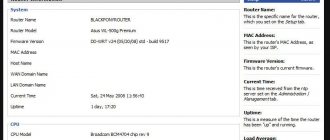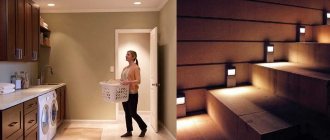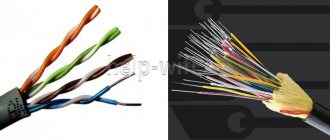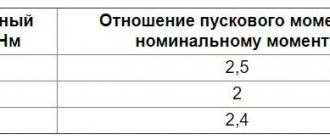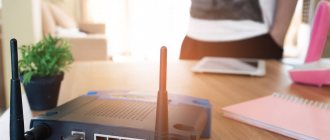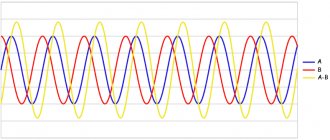A weak WiFi signal is a pressing problem for residents of apartments, country houses and office workers. Dead zones in a WiFi network are typical for both large rooms and small apartments, the area of which even a budget access point can theoretically cover.
The range of a WiFi router is a characteristic that manufacturers cannot clearly indicate on the box: the WiFi range is influenced by many factors that depend not only on the technical specifications of the device.
This material presents 10 practical tips that will help eliminate the physical causes of poor coverage and optimize the range of your WiFi router; you can easily do it yourself.
Install the antennas in a vertical position
The radiation from the access point in space is not a sphere, but a toroidal field, shaped like a donut. In order for WiFi coverage within one floor to be optimal, radio waves must propagate in a horizontal plane - parallel to the floor. For this purpose, it is possible to tilt the antennas.
The antenna is a donut axis. The angle of signal propagation depends on its inclination.
When the antenna is tilted relative to the horizon, part of the radiation is directed outside the room: dead zones are formed under the “donut” plane.
A vertically mounted antenna radiates in a horizontal plane: maximum coverage is achieved indoors.
In practice : Mounting the antenna vertically is the easiest way to optimize indoor WiFi coverage.
How should they be directed?
External antennas on the router, regardless of whether they are removable or not, are fixed movably. Their position can be changed. Many users have a question: how should the antennas be located on a Wi-Fi router, where should they be directed.
Note that there are two types of antennas: narrowly directional and omnidirectional. The first collect the signal into a beam and broadcast it in one specific direction. Omnidirectional broadcasts in all directions. Routers only use omnidirectional ones, so there is no need to aim them anywhere.
However, it is recommended to point the router's antennas upward. Installed in this position, they provide maximum coverage because the signal travels horizontally to the maximum possible distance in all directions.
If you place the antennas horizontally, the signal will propagate vertically, that is, up and down. Which is justified if you need to provide coverage on the upper and lower floors. In an ordinary apartment, it makes sense to place the antennas vertically with a slight slope towards the desired maximum coverage.
The antennas are made movable so that they can be installed as needed in any position of the router. After all, the router can either be installed on a flat surface - on a table or on the floor, or placed vertically on the wall.
As for routers with built-in antennas, some models are recommended to be placed vertically on the wall, since the antennas in them are horizontal . But most models have several of them inside the case, and they are located both horizontally and vertically, ensuring stable operation in any position. It is worth experimenting with different positions of the device to find out in which case the signal will be better.
Place the router closer to the center of the room
Another reason for the occurrence of dead zones is the poor location of the access point. The antenna emits radio waves in all directions. In this case, the radiation intensity is maximum near the router and decreases as it approaches the edge of the coverage area. If you install an access point in the center of the house, the signal will be distributed throughout the rooms more efficiently.
A router installed in a corner transmits some of the power outside the house, and distant rooms are at the edge of the coverage area.
Installation in the center of the house allows you to achieve even distribution of the signal in all rooms and minimize dead zones.
In practice: Installing an access point in the “center” of the house is not always feasible due to the complex layout, lack of sockets in the right place, or the need to lay a cable.
Provide direct visibility between the router and clients
WiFi signal frequency is 2.4 GHz. These are decimeter radio waves that do not bend well around obstacles and have low penetrating ability. Therefore, the range and stability of the signal directly depend on the number and structure of obstacles between the access point and clients.
Passing through a wall or ceiling, an electromagnetic wave loses some of its energy.
The amount of signal attenuation depends on the material the radio waves travel through.
*Effective distance is a value that determines how the radius of a wireless network changes in comparison with open space when a wave passes an obstacle.
Calculation example: WiFi 802.11n signal propagates in line-of-sight conditions over 400 meters. After overcoming the non-permanent wall between the rooms, the signal strength decreases to 400 m * 15% = 60 m. The second wall of the same type will make the signal even weaker: 60 m * 15% = 9 m. The third wall makes signal reception almost impossible: 9 m * 15 % = 1.35 m.
Such calculations will help calculate dead zones that arise due to the absorption of radio waves by walls.
The next problem in the path of radio waves: mirrors and metal structures. Unlike walls, they do not weaken, but reflect the signal, scattering it in arbitrary directions.
Mirrors and metal structures reflect and scatter the signal, creating dead zones behind them.
If you move interior elements that reflect the signal, you can eliminate dead spots.
In practice: It is extremely rare to achieve ideal conditions when all gadgets are in direct line of sight to the router. Therefore, in a real home, you will have to work separately to eliminate each dead zone:
- find out what interferes with the signal (absorption or reflection);
- think about where to move the router (or piece of furniture).
Place the router away from sources of interference
The 2.4 GHz band does not require licensing and is therefore used for the operation of household radio standards: WiFi and Bluetooth. Despite the low bandwidth, Bluetooth can still interfere with the router.
Green areas are the stream from the WiFi router. Red dots are Bluetooth data. The proximity of two radio standards in the same range causes interference, reducing the range of the wireless network.
The magnetron of a microwave oven emits in the same frequency range. The radiation intensity of this device is so high that even through the protective screen of the furnace, the magnetron radiation can “illuminate” the radio beam of the WiFi router.
Microwave oven magnetron radiation causes interference on almost all WiFi channels.
On practice:
- When using Bluetooth accessories near the router, enable the AFH parameter in the settings of the latter.
- The microwave is a powerful source of interference, but it is not used very often. Therefore, if it is not possible to move the router, then you simply won’t be able to make a Skype call while preparing breakfast.
What is needed for production
A long-range Wifi antenna consists of several parts:
- coaxial cable for wifi router;
- reflector to enhance the wifi signal;
- holder for wifi antenna.
- The cable is not an element you should skimp on. It is better to take goods from well-known and trusted brands: Ecoflex, Aircell and others. If the length is short, you can also use standard RG58 - losses will be minimal.
- The holder can be made from any plastic object of small diameter, shaped at least vaguely like a cylinder. The simplest and most affordable option for it is a toothpaste tube cap or a bicycle cap.
- To make a reflector you will need foil fiberglass, getinax or tin. It is better to give preference to the first: it is easy to find in electrical goods stores and the easiest to process, and an antenna made from it with your own hands will turn out to be very powerful. The ideal size is about 15 centimeters in length and width.
Disable support for 802.11 B/G modes
WiFi devices of three specifications operate in the 2.4 GHz band: 802.11 b/g/n. N is the newest standard and provides greater speed and range compared to B and G.
The 802.11n (2.4 GHz) specification provides greater range than legacy B and G standards.
802.11n routers support previous WiFi standards, but the mechanics of backward compatibility are such that when a B/G device appears within the range of the N-router - for example, an old phone or a neighbor's router - the entire network is switched to B/G mode. Physically, the modulation algorithm changes, which leads to a drop in the speed and range of the router.
In practice: Switching the router to “pure 802.11n” mode will definitely have a positive effect on the quality of coverage and throughput of the wireless network.
However, B/G devices will not be able to connect via WiFi. If it is a laptop or TV, they can be easily connected to the router via Ethernet.
Minimize exposure to other devices
Signal strength is directly affected by other equipment. The performance of the router is most affected by devices that emit electromagnetic waves. This includes microwave ovens and old telephones. You can avoid problems by placing these devices further apart from each other.
It is best to place the router in an open area. If, however, other electrical appliances are located nearby, it is recommended to use a second Wi-Fi amplifier. This option is optimal under the current circumstances.
Select the optimal WiFi channel in the settings
Almost every apartment today has a WiFi router, so the density of networks in the city is very high. Signals from neighboring access points overlap each other, draining energy from the radio path and greatly reducing its efficiency.
Neighboring networks operating at the same frequency create mutual interference, like ripples on the water.
Wireless networks operate within a range on different channels. There are 13 such channels (in Russia) and the router switches between them automatically.
To minimize interference, you need to understand which channels neighboring networks operate on and switch to a less loaded one. Detailed instructions for setting up the channel are presented here.
Congestion of WiFi channels in the entrance of a high-rise building.
In practice: Selecting the least loaded channel is an effective way to expand the coverage area, relevant for residents of an apartment building.
But in some cases there are so many networks on the air that not a single channel provides a noticeable increase in WiFi speed and range. Then it makes sense to turn to method No. 2 and place the router away from the walls bordering neighboring apartments. If this does not bring results, then you should think about switching to the 5 GHz band (method No. 10).
Types of Wi-Fi amplifiers
To decide on the existing types of devices, you should know the causes of network failure. This is not always affected by signal strength. Often the coverage range of the amplifying antenna differs from what the manufacturer indicated on the packaging. There are several cases that reduce the speed of data transfer on the network:
- Incorrect installation of equipment in the room. To maximize signal coverage, it is recommended to place the device in the center of the room. Otherwise, the signal will not reach all points.
- Installation next to the microwave. Microwaves emitted by the device negatively affect network coverage. As a result, Internet speed drops or disappears. It is not recommended to place such equipment nearby.
- The walls are made of concrete. This material acts as an insulator. If you try to access the network through such a wall, you risk being left without the Internet. Try not to move too far away from the signal source.
- Low power. If you buy a cheap device, it will have a low range. The further away from the source of action, the slower the speed. In this case, you should think about buying a repeater.
To solve the first two problems, it is enough to select a location for the equipment. In other cases, you cannot do without purchasing additional devices to improve the signal.
These devices allow you to increase your network coverage area without purchasing a new router. Some of them operate in active mode, others in passive mode. Each of them has its own advantages and disadvantages. Possible solutions should be considered.
Adjust the router transmitter power
The power of the transmitter determines the energy of the radio path and directly affects the range of the access point: the more powerful the beam, the further it hits. But this principle is useless in the case of omnidirectional antennas of household routers: in wireless transmission, two-way data exchange occurs and not only clients must “hear” the router, but also vice versa.
Asymmetry: the router “reaches” a mobile device in a distant room, but does not receive a response from it due to the low power of the smartphone’s WiFi module. The connection is not established.
In practice: The recommended transmitter power value is 75%. It should be increased only in extreme cases: turning the power up to 100% not only does not improve the quality of the signal in distant rooms, but even worsens the stability of reception near the router, since its powerful radio stream “clogs” the weak response signal from the smartphone.
Replace the standard antenna with a more powerful one
Most routers are equipped with standard antennas with a gain of 2 - 3 dBi. The antenna is a passive element of the radio system and is not capable of increasing the flow power. However, increasing the gain allows you to refocus the radio signal by changing the radiation pattern.
Antenna gain is similar to focusing a flashlight beam: a narrow beam shines further than a wide beam.
The higher the antenna gain, the further the radio signal travels. In this case, the narrower flow becomes similar not to a “donut”, but to a flat disk.
There is a large selection of antennas for routers with a universal SMA connector on the market.
Replaceable omnidirectional antenna.
Omnidirectional whip antenna.
Directional indoor antenna.
In practice: Using an antenna with high gain is an effective way to expand the coverage area, because simultaneously with the signal amplification, the sensitivity of the antenna increases, which means the router begins to “hear” remote devices. But due to the narrowing of the radio beam from the antenna, dead zones appear near the floor and ceiling.
What is the range of Wi-Fi antennas
Often the distance is the most important parameter, for the sake of which the garden itself is fenced. Therefore, the question: over what distance can wifi be transmitted is of paramount importance. Several factors play into range. First of all, this is a line of sight zone. There should be no obstacles on the path between the receiver and transmitter. These distances can be increased by raising them to a certain height. The second point is the size and number of emitters. And the last thing is the directivity of the antenna. In the following, we will look at two types of antennas and their main features.
But it is worth understanding the following: the narrower the radiation pattern of a particular antenna, the higher its gain. But at a large distance and a narrow radiation pattern, any swing of the antenna by the wind will lead to the communication being uncertain. Therefore, they try to find a middle ground between the gain and the width of the radiation pattern. In reality, a good gain would be around 12 dB.
Use signal repeaters
In rooms with complex layouts and multi-story buildings, it is effective to use repeaters - devices that repeat the signal from the main router.
Repeaters expand the WiFi network, covering the surrounding area and the upper floors of a country house.
Repeaters help deploy a wireless network in rooms with complex layouts.
The simplest solution is to use an old router as a repeater. The disadvantage of this scheme is that the throughput of the child network is half as much, since along with client data, the WDS access point aggregates the upstream flow from the upstream router.
Detailed instructions for setting up a WDS bridge are provided here.
A router in WDS mode helps expand WiFi network coverage.
Specialized repeaters do not have the problem of reducing bandwidth and are equipped with additional functionality. For example, some Asus repeater models support the roaming function.
In roaming mode, devices automatically connect to a more powerful network, and the connection is not lost when moving between access points.
In practice: No matter how complex the layout, repeaters will help you deploy a WiFi network. But any repeater is a source of interference interference. When there is free air, repeaters do their job well, but with a high density of neighboring networks, the use of repeater equipment in the 2.4 GHz band is impractical.
